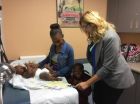(Press-News.org) Bottom Line: Breastfeeding by mothers treated with antiepileptic drug (AED) therapy was not associated with adverse effects on cognitive function in children at 6 years.
Author: Kimford J. Meador, M.D., of Stanford University, California, and colleagues for the Neurodevelopmental Effects of Antiepileptic Drugs (NEAD) Study Group.
Background: Some concern has been raised that breastfeeding by mothers being treated with AED therapy may be harmful to the child because some AEDs can cause neuronal apoptosis (cell death) in immature animal brains.
How the Study Was Conducted: The study is an ongoing investigation of neurodevelopmental effects of AEDs on cognitive outcomes in children of mothers with epilepsy treated with AEDs. Preliminary results at age 3 years found no difference in IQ for children who breastfed vs. those who did not. However, IQ at age 6 years is more predictive of school performance and adult abilities. The study assessed 181 children at 6 years for whom investigators had both breastfeeding and IQ data.
Results: Nearly 43 percent of the children were breastfed an average of seven months. IQ at age 6 years was related to drug group (IQ worse by 7-13 points for valproate compared to other drugs); drug dosage (higher dosage associated with lower IQ with the effect driven by valproate); higher maternal IQ associated with higher child IQ; folate use around the time of conception associated with higher IQ; and higher IQ associated with breastfeeding. Breastfed children also had higher verbal abilities than children who were not breastfed. The potential deleterious effects of AED exposure from breast milk in newborns who have not been previously exposed in utero are not addressed by the study.
Discussion: "Our study does not provide a final answer, but we recommend breastfeeding to mothers with epilepsy, informing them of the strength of evidence for risks and benefits. Our recommendation is based on the known positive effects of breastfeeding, the results of our study, an unsubstantiated speculative risk, and theoretical reasons why breastfeeding when taking AEDs would not offer additional risk."
INFORMATION:
(JAMA Pediatr. Published online June 16, 2014. doi:10.1001/jamapediatrics.2014.118. Available pre-embargo to the media at http://media.jamanetwork.com.)
Editor's Note: Authors made conflict of interest disclosures. This work was supported by grants from the National Institutes of Health National Institute of Neurological Disorders and Stroke and a grant from the United Kingdom Epilepsy Research Foundation. Please see article for additional information, including other authors, author contributions and affiliations, etc.
Editorial: Breastfeeding in Children of Mothers with Epilepsy
In a related editorial, Cynthia L. Harden, M.D., of North Shore-Long Island Jewish Health System, Great Neck, N.Y., writes: "The most conservative interpretation of these results is that breastfeeding is safe for women taking these AEDs as monotherapy and should be strongly encouraged by all participants in their care, including neurologists, pediatricians, obstetricians and allied health professionals."
(JAMA Pediatr. Published online June 16, 2014. doi:10.1001/jamapediatrics.2014.420. Available pre-embargo to the media at http://media.jamanetwork.com.)
Editor's Note: The author made conflict of interest disclosures. Please see article for additional information, including other authors, author contributions and affiliations, etc.
Media Advisory: To contact author Kimford J. Meador, M.D., call Michelle L. Brandt at 650-723-0272 or email mbrandt@stanford.edu. To contact editorial author Cynthia L. Harden, M.D., call Anthony Davenport at 516-465-2755 or email Adavenport@NSHS.edu.
No adverse cognitive effects in kids breastfed by moms using antiepileptic drugs
2014-06-16
ELSE PRESS RELEASES FROM THIS DATE:
Majority of older breast cancer patients use hormone treatment
2014-06-16
WASHINGTON — One of the most comprehensive looks at the use of hormone therapy in women over 65 with non-metastatic breast cancer found some welcome news. Except for frail patients, most participants in the large study complied with their oncologists' recommendations to treat their estrogen-positive breast cancer with hormone therapy — either an aromatase inhibitor or tamoxifen. These drugs prevent tumors from using estrogen to fuel growth.
But the study, reported online June 16th in the Journal of Clinical Oncology, also found that non-white women were much more likely ...
Major surgery associated with increased risk of death or impairment in very-low-birth-weight infants
2014-06-16
Bottom Line: Very-low-birth-weight (VLBW) babies who undergo major surgery appear to have an increased risk of death or subsequent neurodevelopmental impairment (NDI).
Author: Frank H. Morriss, Jr., M.D., M.P.H., of the University of Iowa, Iowa City, and colleagues.
Background: Some animal studies suggest general anesthesia for surgery can increase the risk for neurocognitive or behavioral deficits. This has raised some concerns about exposing infants to general anesthesia for surgery.
How the Study Was Conducted: The authors examined the association between ...
Military personnel with concussive TBI caused by blast or nonblast event no difference in outcomes
2014-06-16
Bottom Line: Military personnel with concussive traumatic brain injury (TBI) caused by a blast or a nonblast-related event had similar outcomes, including headache severity and depression.
Author: Christine L. Mac Donald, Ph.D., of the Washington University School of Medicine, St. Louis, and colleagues.
Background: It has been estimated that in the U.S. military about 20 percent of the deployed force experienced a head injury in the wars in Iraq and Afghanistan. Of those injured, about 83 percent had a mild, uncomplicated TBI or concussion. Blast injuries were the ...
Outreach doubles colon cancer screening in low-income communities
2014-06-16
CHICAGO --- In low-income and minority communities where colonoscopies may be prohibitively expensive for many residents, less-invasive, more frequent testing combined with automated reminders, can yield dramatic improvements in colorectal cancer (CRC) screening rates, according to a new Northwestern Medicine® study.
The study found that community health center patients who received follow-up -– that is, outreach by mail, automated telephone and text messages, and calls by a health center staff member if no response was given in three months -- were more than twice as ...
Penn anesthesiologists identify top 5 practices that could be avoided
2014-06-16
(PHILADELPHIA) – A team of researchers led by Penn Medicine anesthesiologists have pinpointed the "top five" most common perioperative procedures that are supported by the least amount of clinical evidence, in an effort to direct providers to make more cost-effective treatment decisions. Their findings are published in the current issue of JAMA Internal Medicine.
The team surveyed anesthesiologists, many of them in academic practice, to identify the most common activities that should be questioned in the field, using practice parameters developed by the American Society ...
In military personnel, no difference between blast and nonblast-related concussions
2014-06-16
Explosions are the most common cause of traumatic brain injuries in veterans returning from Iraq and Afghanistan. A new study shows that military personnel with mild brain trauma related to such blasts had outcomes similar to those with mild brain injury from other causes, according to researchers at Washington University School of Medicine in St. Louis.
However, nearly 80 percent of patients in both categories of brain trauma suffered moderate to severe overall disability within a year after injury.
The analysis appears June 16 in JAMA Neurology.
"We are interested ...
How to prevent disparities in colon cancer screening
2014-06-16
SEATTLE—People living in poverty are less likely to be screened regularly for colorectal cancer—and more likely to develop the disease and die from it. How to end these disparities—and raise screening rates, lower disease rates, and prevent deaths? A promising way is to mail fecal immunochemical tests (a newer kind of stool test) to populations, Beverly B. Green, MD, MPH, and Gloria D. Coronado, PhD, wrote in the June 17 JAMA Internal Medicine.
Dr. Green is a Group Health physician and an associate investigator at Group Health Research Institute. Dr. Coronado is a senior ...
When patients wish for a miracle, tool helps medical staff say 'amen'
2014-06-16
Cancer clinicians and a chaplain at the Johns Hopkins Kimmel Cancer Center have developed a new tool to help doctors, nurses and other health care providers talk to dying patients and families who are, literally, praying for a miracle.
The AMEN (Affirm, Meet, Educate, No matter what) protocol, a script that can be used by medical staff, offers a way to negotiate these challenging conversations to affirm or acknowledge a patient's hope, share the patient's wish with others, continue to educate the patient and family about medical issues, and assure them that their health ...
Redesigning the well-child checkup
2014-06-16
Well-child visits are the foundation of pediatric primary care in the U.S. Accounting for more than one-third of all outpatient visits for infants and toddlers, the appointments are intended to give doctors the opportunity to identify health, social, developmental and behavioral issues that could have a long-term impact on children's lives.
However, several studies have shown that the current system of well-child care leaves room for improvement. One major concern is that well-child care guidelines issued by the American Academy of Pediatrics call for physicians to provide ...
Many bodies prompt stem cells to change
2014-06-16
HOUSTON – (June 16, 2014) – How does a stem cell decide what path to take? In a way, it's up to the wisdom of the crowd.
The DNA in a pluripotent stem cell is bombarded with waves of proteins whose ebb and flow nudge the cell toward becoming blood, bone, skin or organs. A new theory by scientists at Rice University shows the cell's journey is neither a simple step-by-step process nor all random.
Theoretical biologist Peter Wolynes and postdoctoral fellow Bin Zhang set out to create a mathematical tool to analyze large, realistic gene networks. As a bonus, their open-access ...



